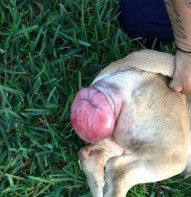Canine Vagina Monologue (What It Has To Say May Surprise You)
“Doctor, there’s something weird sticking out of my dog, you know…down there!”
 With the exception of anal sacs (“I swear my dog does not do that”), no anatomical region is as awkward for pet owners to discuss with their vets. For some reason, people have an issue with saying the word ‘vagina’ while maintaining eye contact. Instead, veterinarians understand what clients mean when they euphemistically refer to ‘lady parts’ or ‘downtown’ or ‘ninky-nonk.’ Well, we are all adults here (sorta) so let us set aside our embarrassment and provide a brief discussion of abnormal things that can emerge from your dog’s vagina.
With the exception of anal sacs (“I swear my dog does not do that”), no anatomical region is as awkward for pet owners to discuss with their vets. For some reason, people have an issue with saying the word ‘vagina’ while maintaining eye contact. Instead, veterinarians understand what clients mean when they euphemistically refer to ‘lady parts’ or ‘downtown’ or ‘ninky-nonk.’ Well, we are all adults here (sorta) so let us set aside our embarrassment and provide a brief discussion of abnormal things that can emerge from your dog’s vagina.
Vaginal and vulvar tumors are the second most common tumor of the canine reproductive tract. They occur exclusively in (ready?) female dogs! Fortunately, the vast majorities are benign, but rare cancers do occur. The most common tumors arise from smooth muscle or collagen-producing cells, and go by the multisyllabic names of leiomyoma, fibroma, or fibroleiomyoma. In some cases your dog may show symptoms such as difficulty urinating, vaginal discharge, licking at her vulva, or trouble birthing or copulating. In other cases, you may be completely unaware of a growing tumor until it pops out one day with a “Howdy Ho!”
 When you bring your dog to the vet, most likely with a mild degree of panic, the existence of this pink, fleshy mass hanging out of the vulva will be quite obvious. Nevertheless, expect your vet to recommend a few additional tests: blood and urine tests to check your pet’s overall health, and biopsies to confirm the type of mass. There are a few other fleshy, non-tumor things that can protrude from the vagina, and an accurate diagnosis is imperative. Vaginal hyperplasia is an estrogen-dependent, exaggerated swelling of the lining of the vagina. These typically occur when a bitch is in heat and resolve spontaneously during diestrus. They appear as a tongue-like projection from the floor of the vagina. Another possibility is a vaginal prolapse where the entire vagina turns inside out and appears as a red, donut-shaped mass hanging of the vulva. Finally, a uterine prolapse occurs when a portion of the uterus falls through the cervix, typically during or shortly after delivery of pups. These would require different therapies. If there is any question, your vet may recommend additional imaging such as X-rays, ultrasonography, vaginoscopy, MRI, or CT scan.
When you bring your dog to the vet, most likely with a mild degree of panic, the existence of this pink, fleshy mass hanging out of the vulva will be quite obvious. Nevertheless, expect your vet to recommend a few additional tests: blood and urine tests to check your pet’s overall health, and biopsies to confirm the type of mass. There are a few other fleshy, non-tumor things that can protrude from the vagina, and an accurate diagnosis is imperative. Vaginal hyperplasia is an estrogen-dependent, exaggerated swelling of the lining of the vagina. These typically occur when a bitch is in heat and resolve spontaneously during diestrus. They appear as a tongue-like projection from the floor of the vagina. Another possibility is a vaginal prolapse where the entire vagina turns inside out and appears as a red, donut-shaped mass hanging of the vulva. Finally, a uterine prolapse occurs when a portion of the uterus falls through the cervix, typically during or shortly after delivery of pups. These would require different therapies. If there is any question, your vet may recommend additional imaging such as X-rays, ultrasonography, vaginoscopy, MRI, or CT scan.
The initial treatment is designed to protect the mass from bleeding, drying, or self-mutilation. Lubricants are applied, and your dog will be instructed to wear an Elizabethan collar to stop her from licking. Tucking the mass back inside may seem logical, but without further treatment, it will pop out again (can you say, “Whackamole?”) Ultimately, surgical removal of these tumors is warranted, usually necessitating an episiotomy. Since many of these tumors are hormone-dependent, the removal of your dog’s ovaries and uterus will be recommended as well. Don’t fret, however. As shocking as their appearance can be, canine vaginal tumors usually lend themselves very well to ‘downtown’ beautification!

